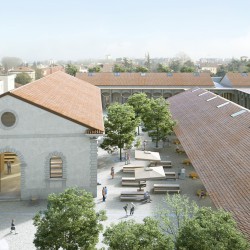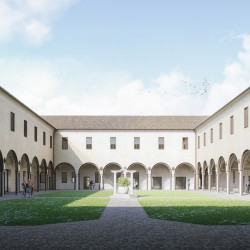Bak Gordon Arquitectos . renders: © SFSight
If we were to refer to one of the most distinctive marks of the city of Padova in terms of its urban structure, it would be inevitable to account for a network of covered porticos/galeries that organize the routes and open up to define square spaces, public places of community convergence.
This network of gantry cranes and empty spaces lends the city and its urban environment a unique atmosphere in which the public space offers itself more comfortable, and where urban life gains an intimate character and an almost domestic taste.
Urban Space
The most dominant buildings are surrounded by squares and empty spaces, creating an interesting ambiguity between positive and negative, in which both contribute to the virtues of urban space.
This way of building the city is also a response to the geographical and climatic conditions of the place, protecting the urban habitability from the adverse winter conditions or the hot summers of the Padovana plain.
New Campus/Hortus Magnus
The first condition that the new campus project imposes on itself is to extend the city of Padova again to the site of the convent of St. Augustine, replacing an isolated and forgotten space with a place of the future that will once again become a new gateway to the city and a strategic place for urban development.
It is therefore essential to build an urbanity in this place that constitutes a morphological continuity with the historic centre, recreating a new Hortus Magnus, a new school capable of spreading knowledge, and becoming the motor of aggregation between a highly qualified scientific community and the citizens who will find a natural extension of their city here.
Portico/Aqueduct (System and Infrastructure)
The idea of portico and aqueduct, merged into a single element and transformed into an urban infrastructure capable of generating a regulatory system, constitutes the DNA of the project.
It is this genetic instruction, the origin of which is gathered in the remote history of the city and its functioning, that is here manipulated to ensure a system capable of associating all times and architectures, full and empty spaces, structuring the territory and ensuring it a technical infrastructure, technological and highly effective, giving rise to a place that is both timeless and absolutely new.
This system is used to ensure connections between all campus buildings, providing crossings and covered living areas, while ensuring a network of technical infrastructure connections between all volumes built. This technological and systemic network does not need to be transported underground, thus avoiding all confrontations with a potential archaeological site and offering itself as an accessible and easily maintained element.
But it is also this portico/aqueduct that organizes and sizes the whole structure of the place, subdividing the different sectors, giving rise to a matrix of empty spaces with defined but absolutely permeable limits.
Perhaps one of the most interesting aspects of this system is the fact that it is possible, through its materialization, to define both the exterior covered spaces and the new buildings, without the need for any other architecture than that of its own genesis.
_
COMPETITION PIAVEFUTURA
CAMPUS FOR PADUA UNIVERSITY
Architecture Coordination. Bak Gordon Arquitectos,
Consultants and Associates. Studio Muratori & Zanon, Studio Associato Tranchida, Studio Campanella Tessoni, STC Group, PROAP, Ar.glo. Engineering Group, Geoarcheologi Associati, Antonio Buggin, Federico Muratori and Luciano Ricci
Collaboration. José Pedro Cano, Pietro Dardano, Fábio Ferreira, Maria Barreiros, Barbara Fonseca, João Aires Neves
Site location. Padova, Italy
Client. Università Degli Studi di Padova
Areas. 29.315m² Construction
Date. Competition 2019
Cost. 46.796.933,00€
Images. Stefano Farina
Estrutura Urbana Se quiséssemos referir uma das marcas mais distintivas da cidade de Pádova, no que à sua estrutura urbana diz respeito, seria inevitável dar conta de uma rede de pórticos/ galerias cobertas que organizam os percursos e se abrem para definir espaços de praça, lugares públicos de convergência comunitária. Esta rede de pórticos e espaços vazios empresta à cidade e ao seu ambiente urbano uma atmosfera única em que o espaço publico se oferece mais confortável, e onde a vida urbana ganha um carácter intimo e um sabor quase domestico. Os edifícios mais preponderantes são envolvidos por praças e espaços vazios, criando uma interessante ambiguidade entre positivo e negativo, em que ambos contribuem para as virtudes do espaço urbano. Este modo de construir a cidade é também uma resposta às condições geográficas e climáticas do lugar, protegendo a habitabilidade urbana das condições adversas do Inverno ou dos verões quentes da planície Padovana. Novo Campus/Hortus Magnus A primeira condição que o projecto do novo campus impõem a si próprio é a de estender de novo a cidade de Pádova até ao lugar do convento de santo agostinho, substituindo um espaço isolado e esquecido por um lugar de futuro que volte a ser uma nova porta da cidade e um lugar estratégico de desenvolvimento urbano. É para isso indispensável edificar uma urbanidade neste lugar que constitua uma continuidade morfológica com o centro histórico, recriando um novo Hortus Magnus, uma nova escola capaz de difundir o saber e o conhecimento, e voltar a ser o motor de agregação entre uma comunidade científica altamente qualificada e os cidadãos que aqui encontrarão uma extensão natural da sua cidade. Pórtico/Aqueduto (Sistema e Infraestrutura) A ideia de pórtico e aqueduto fundidos num único elemento e transformados numa infraestrutura urbana capaz de gerar um sistema regulador constitui o DNA do projecto. É esta instrução genética, cuja origem é colhida na historia remota da cidade e do seu funcionamento, que aqui se manipula para garantir um sistema capaz de associar todos os tempos e arquitecturas, espaços cheios e vazios, estruturar o território e assegurar-lhe uma infraestrutura técnica, tecnológica e altamente eficaz, dando origem a um lugar simultaneamente intemporal e absolutamente novo. Este sistema é utilizado para assegurar as ligações entre todos os edifícios do campus, disponibilizando atravessamentos e áreas de estadia cobertas, ao mesmo tempo que garante uma rede de ligações de infraestruturas técnicas entre todos os volumes construídos. Esta rede tecnológica e sistémica, dispensa ser transportada em subsolo evitando assim todos os confrontos com um potencial campo arqueológico e oferecendo-se como elemento acessível e de fácil manutenção. Mas é também este pórtico/aqueduto que organiza e dimensiona toda a estrutura do lugar, subdividindo os diferentes setores, dando origem a uma matriz de espaços vazios com limites definidos mas absolutamente permeáveis. Talvez um dos aspectos mais interessantes deste sistema seja o facto de se poder, através da sua materialização, definir quer espaços cobertos exteriores, quer as novas edificações, sem necessidade de outra arquitectura que não a da sua própria génese.













